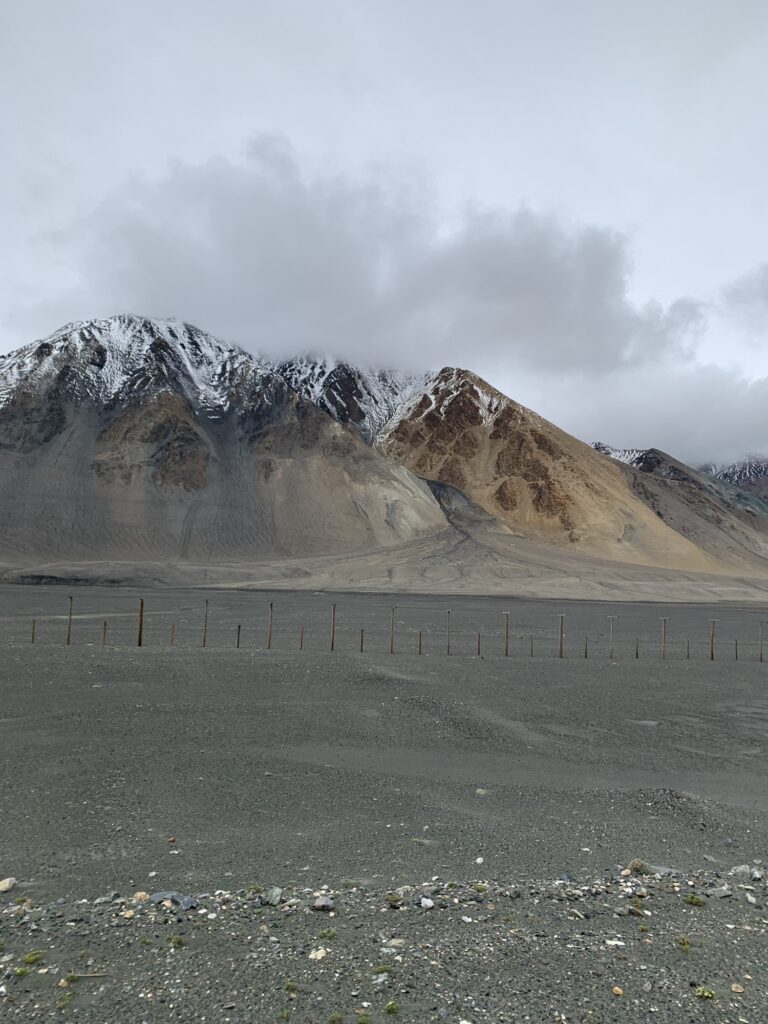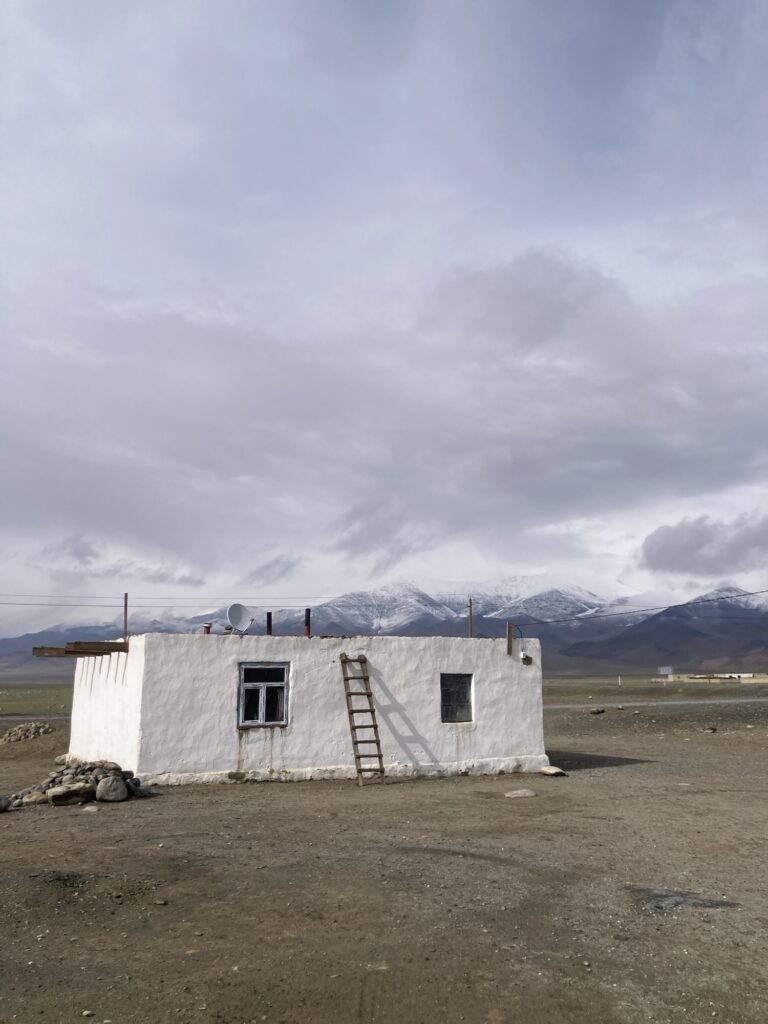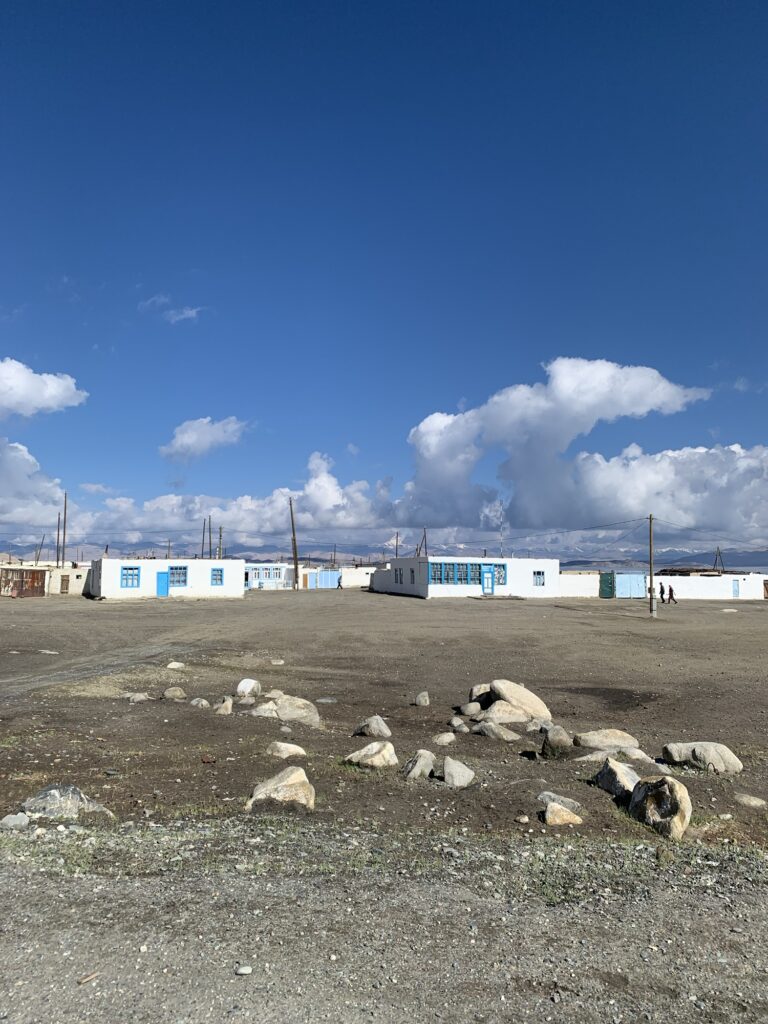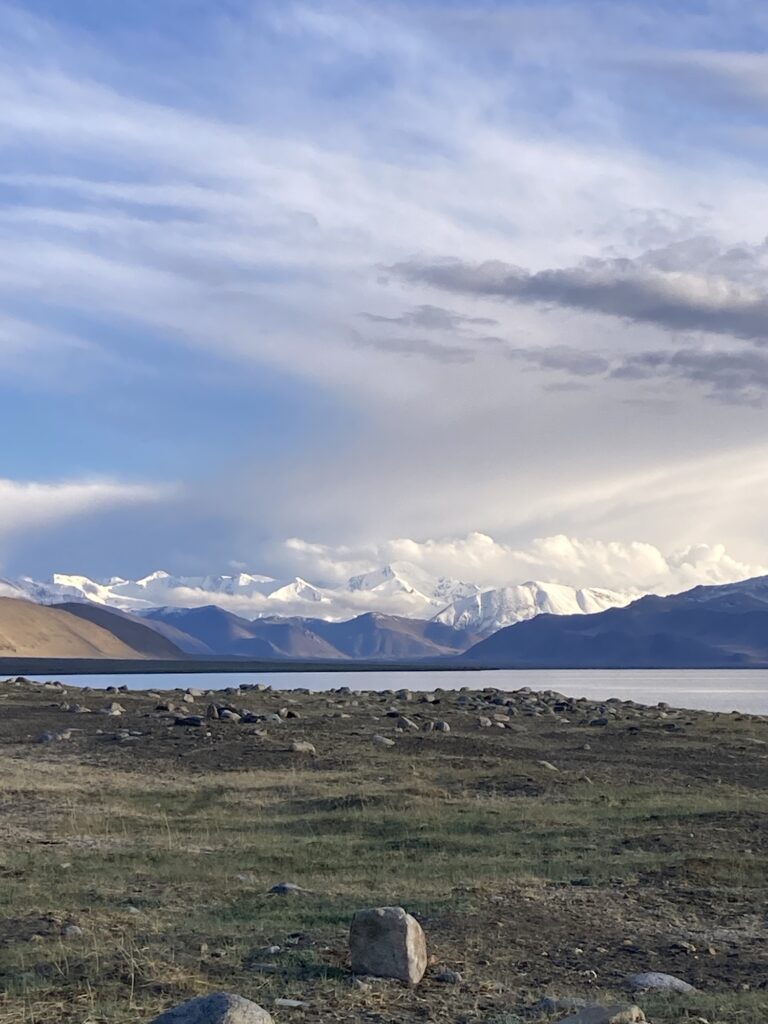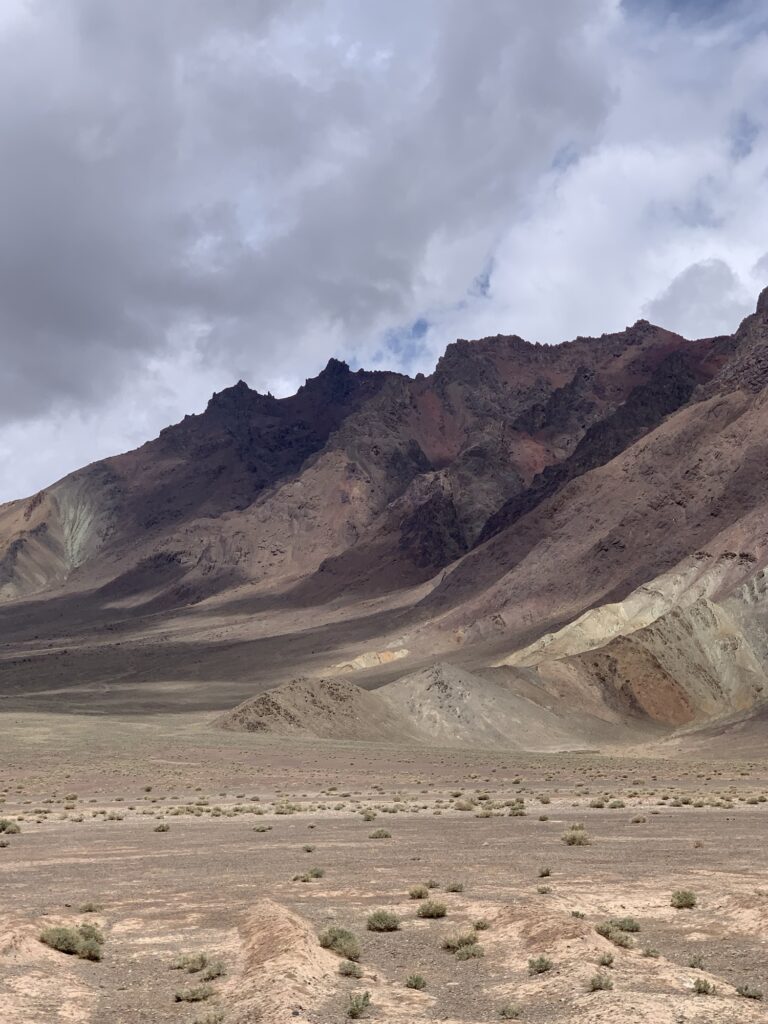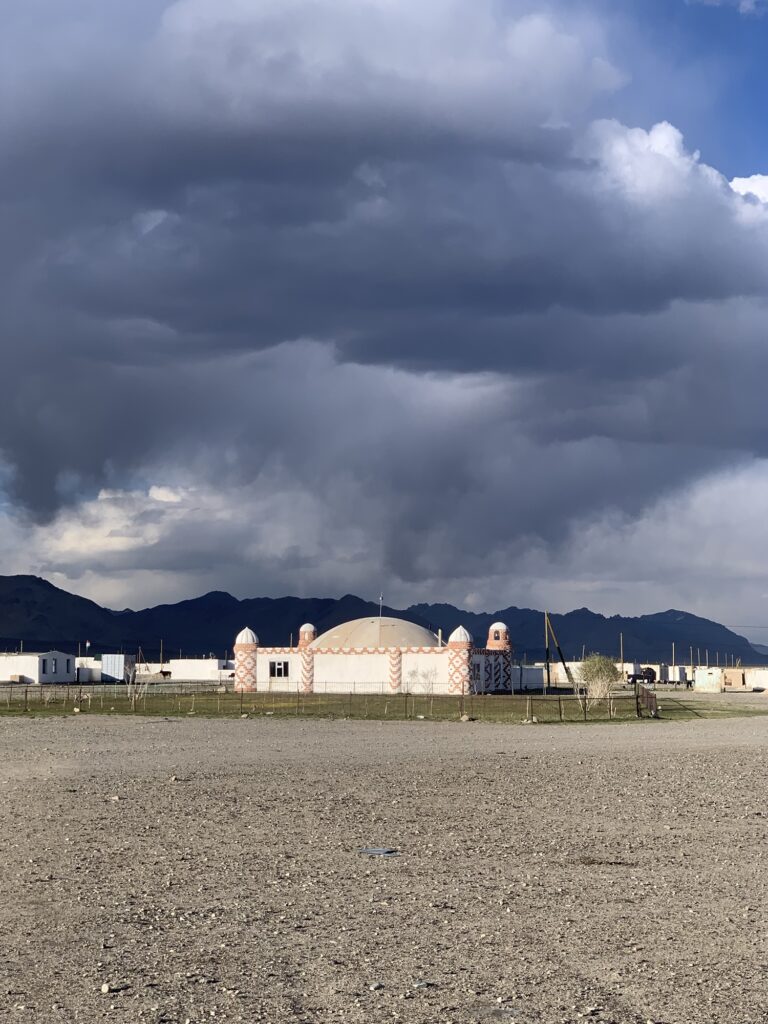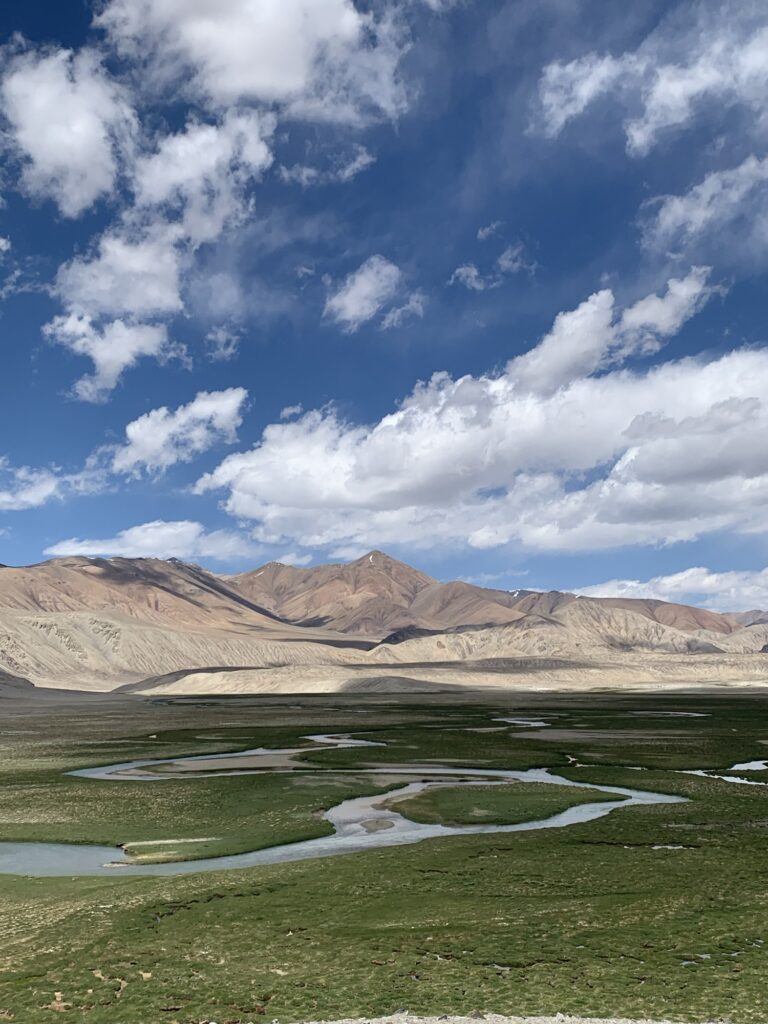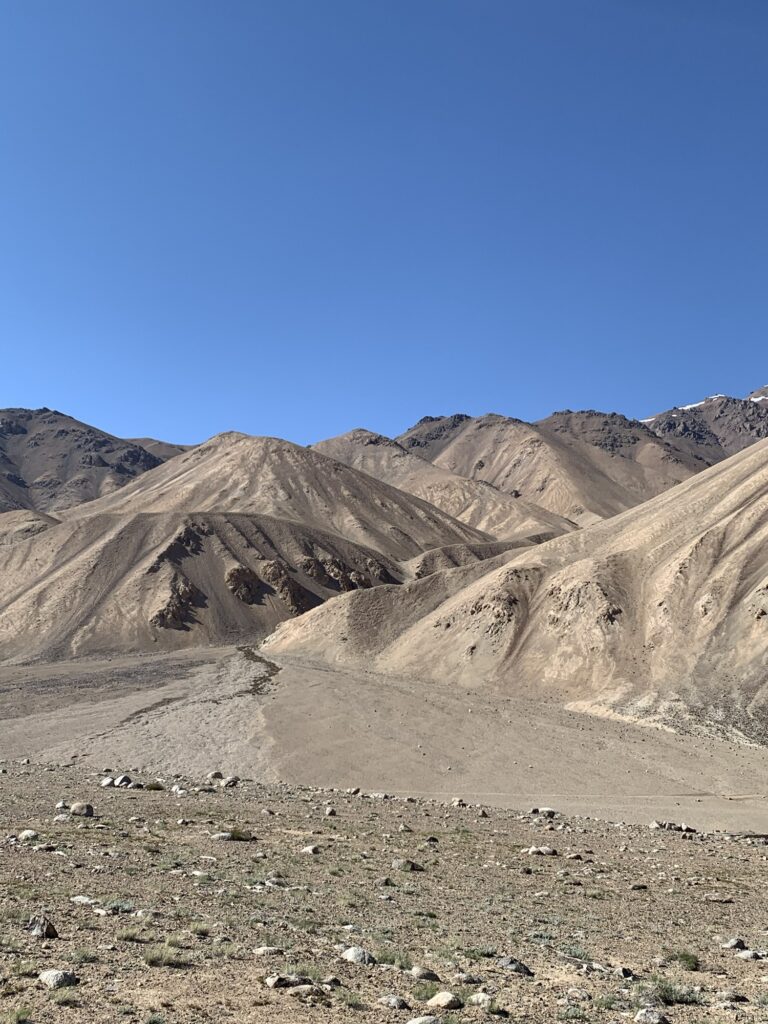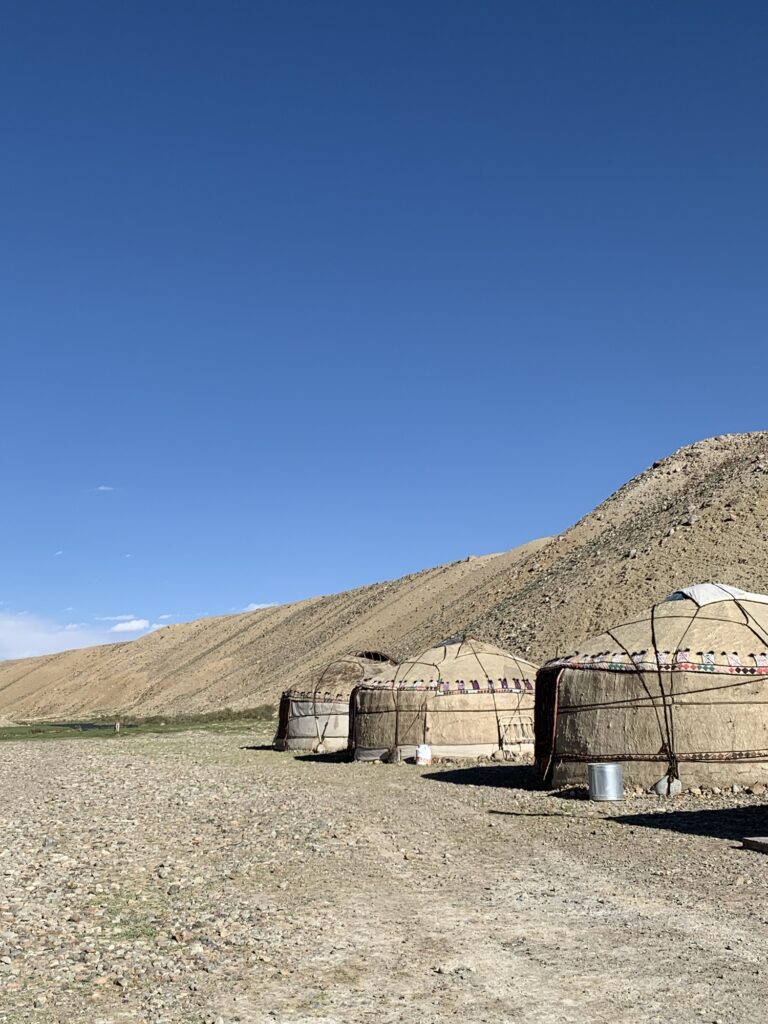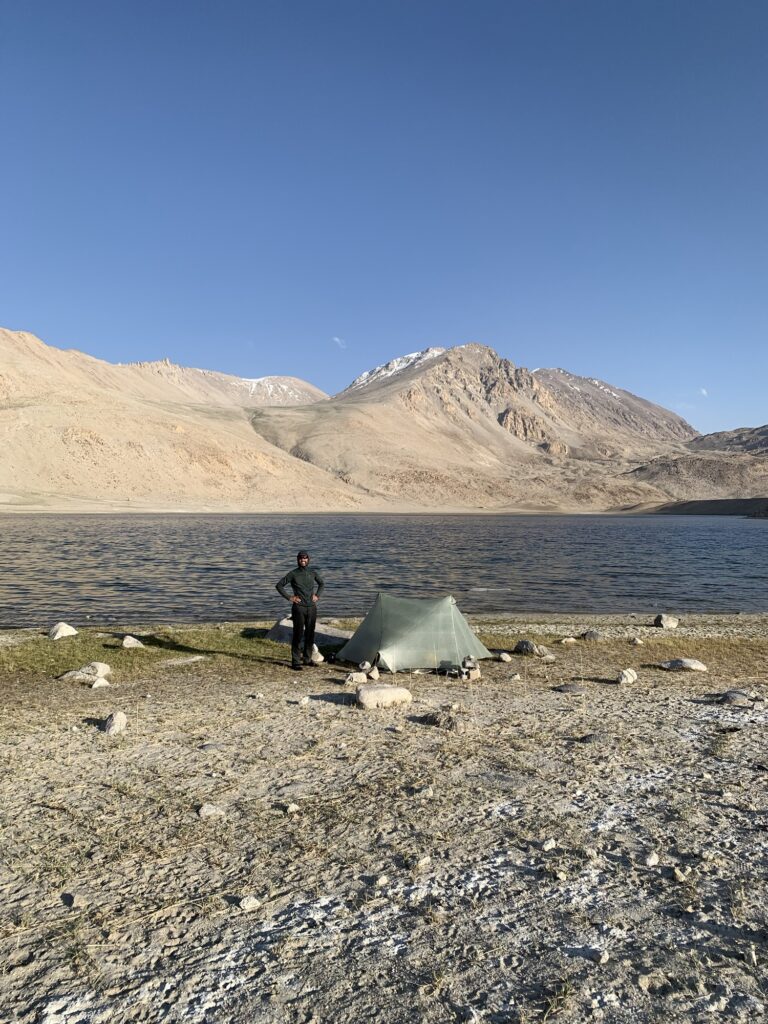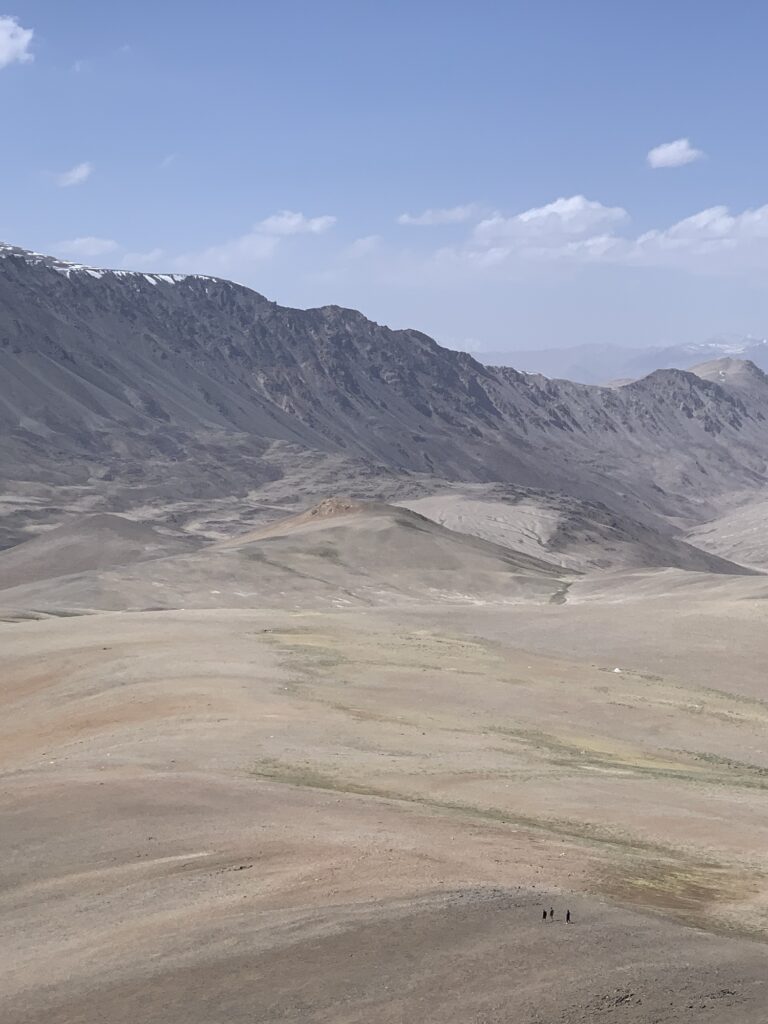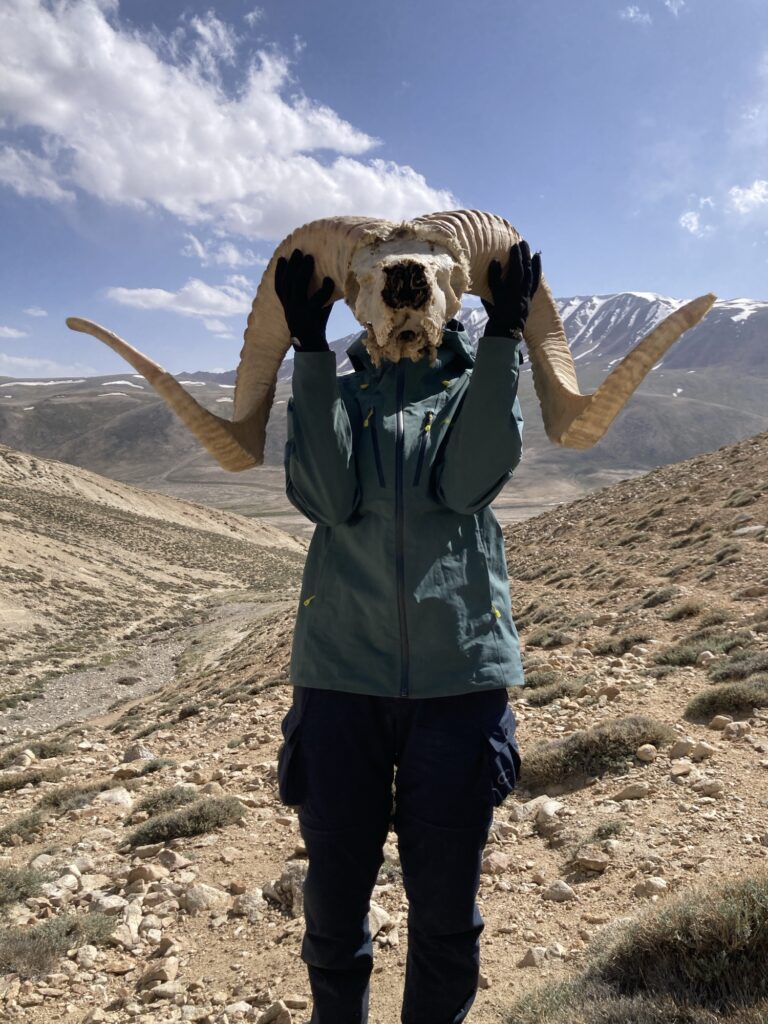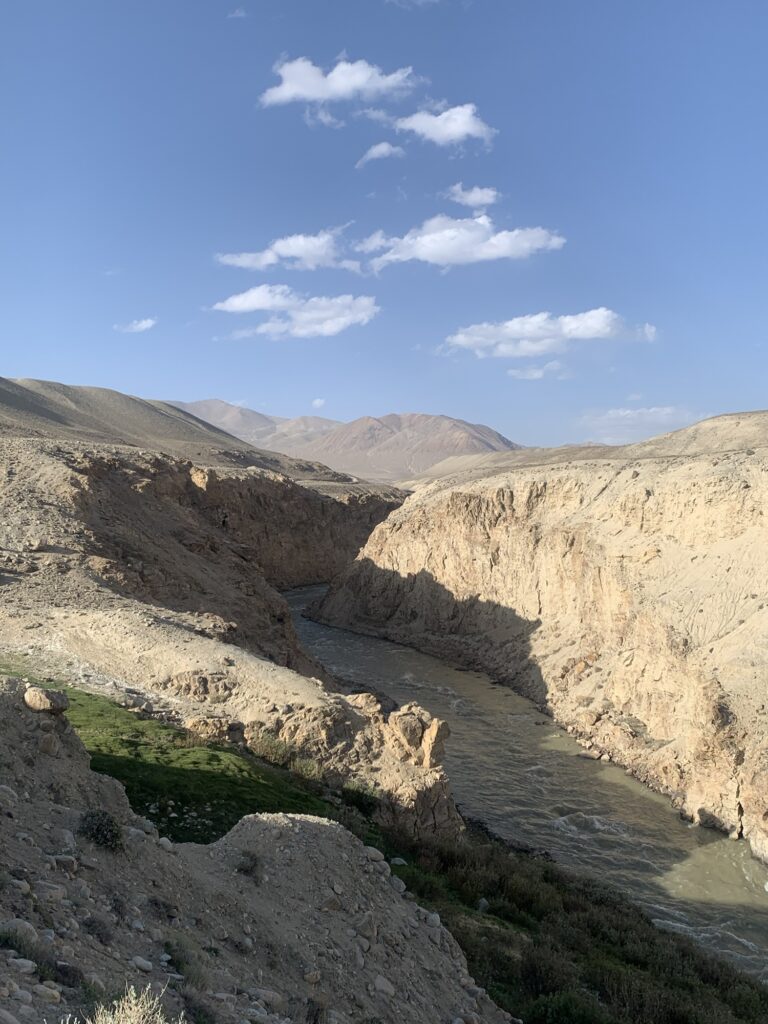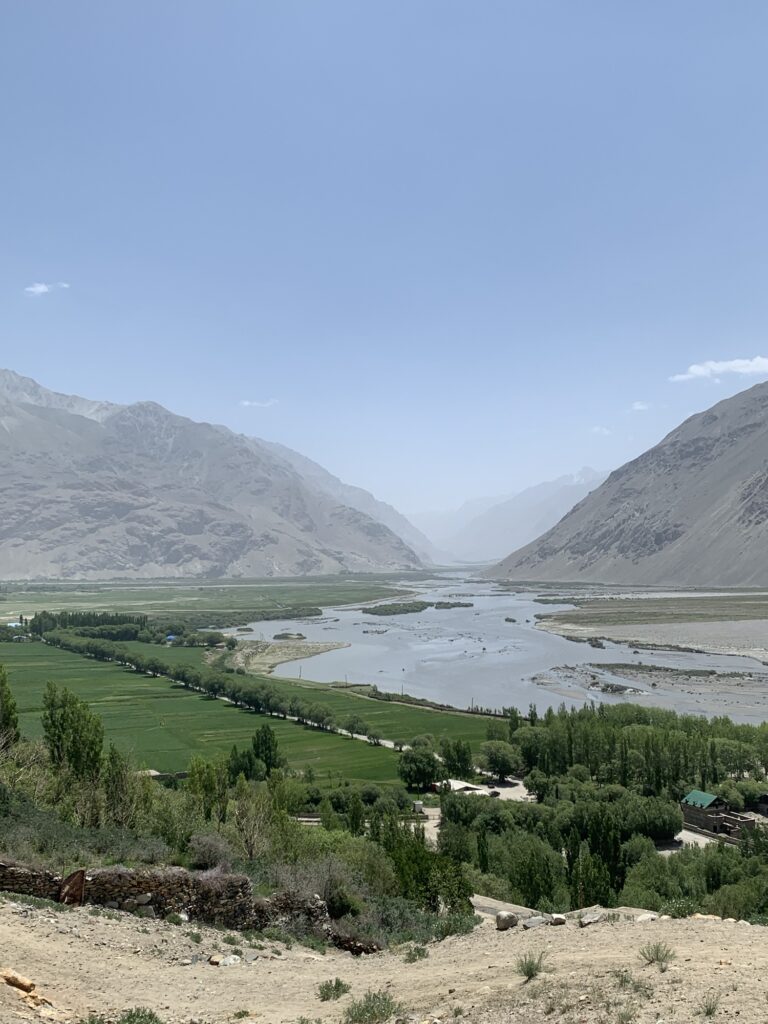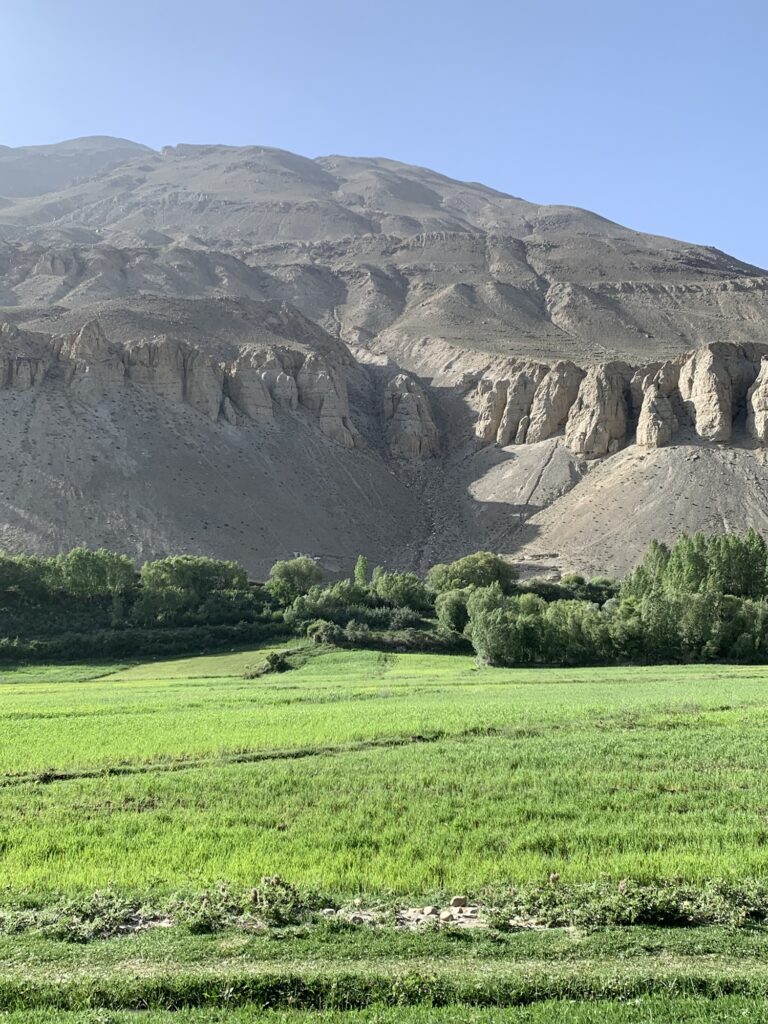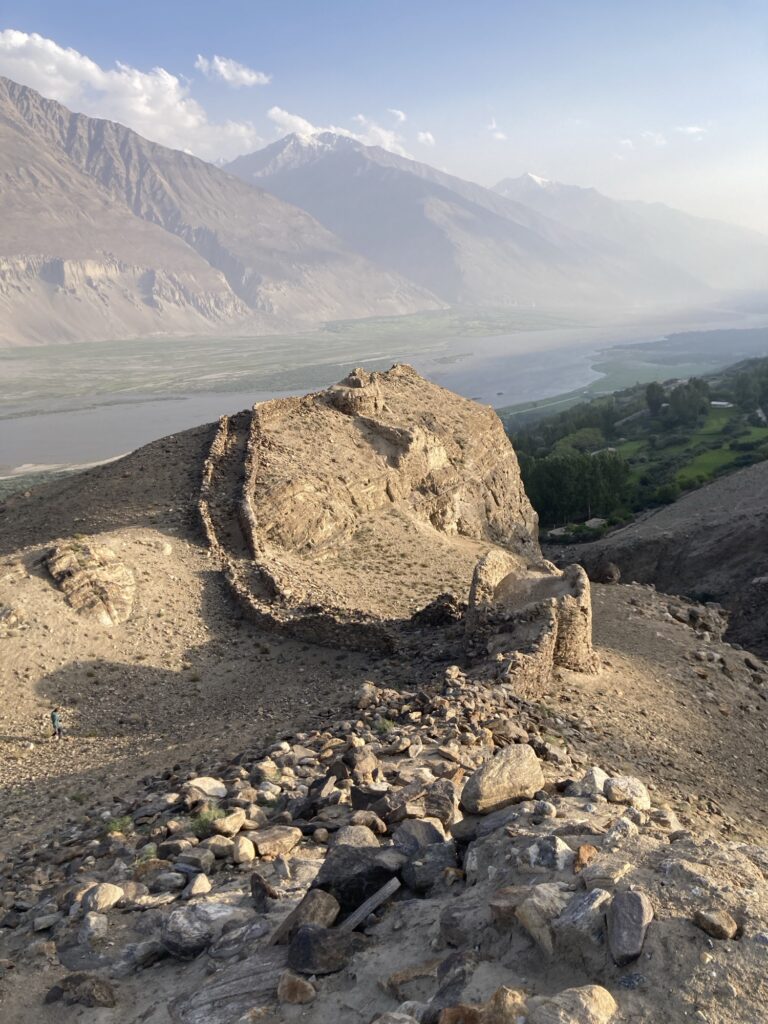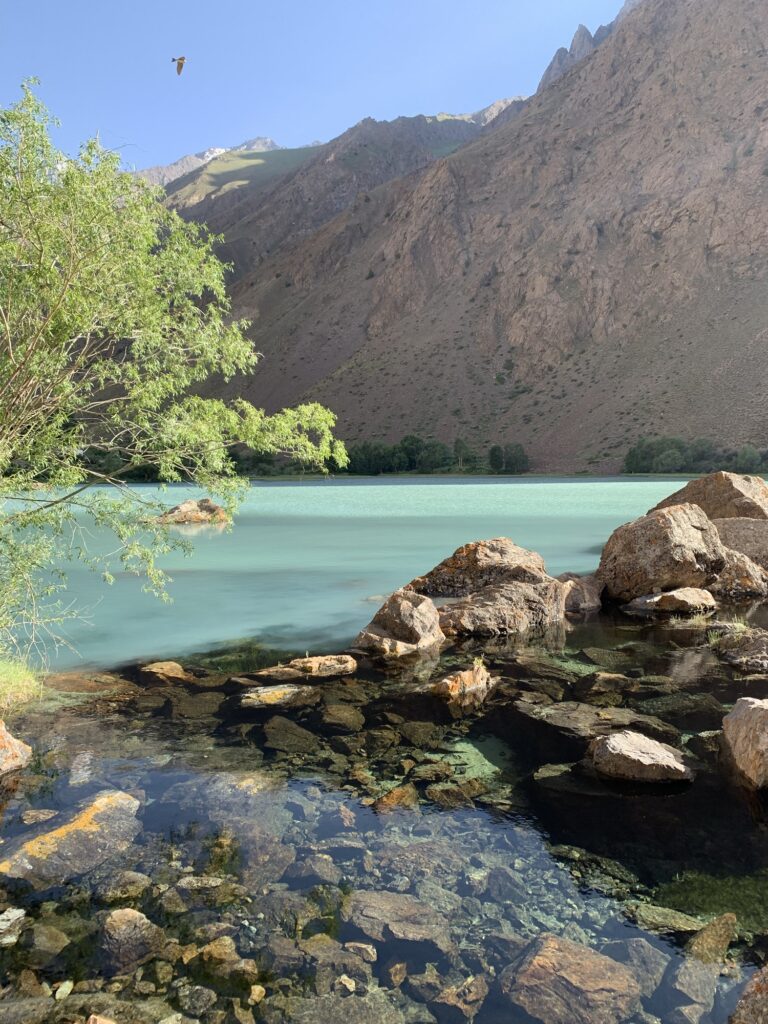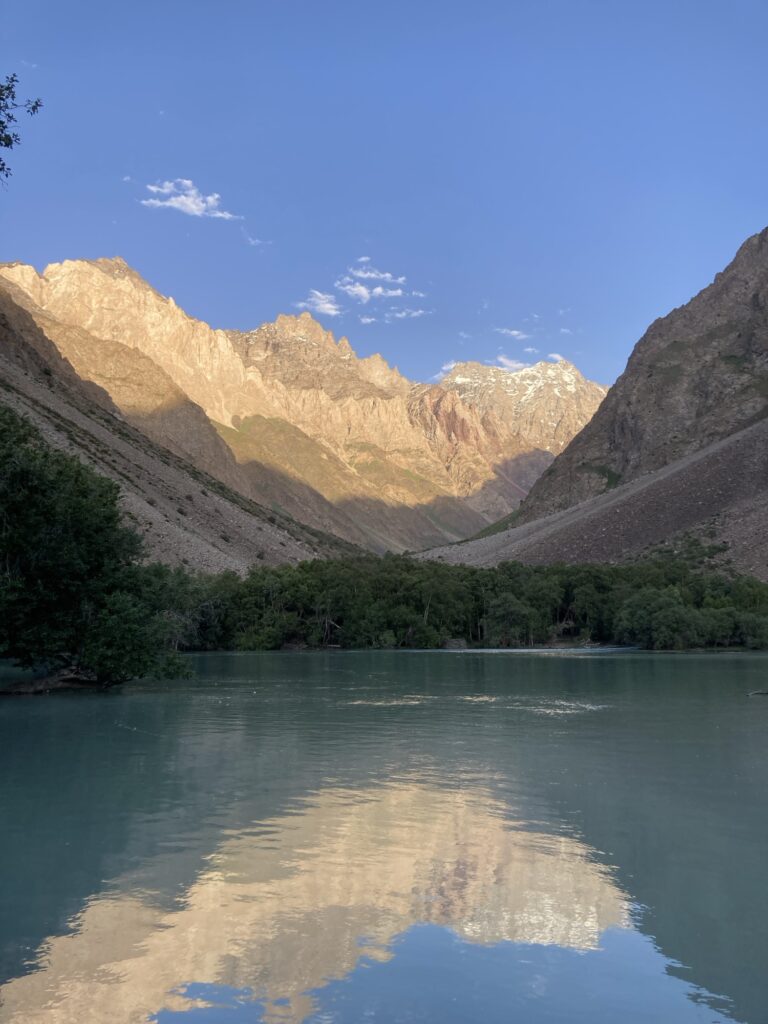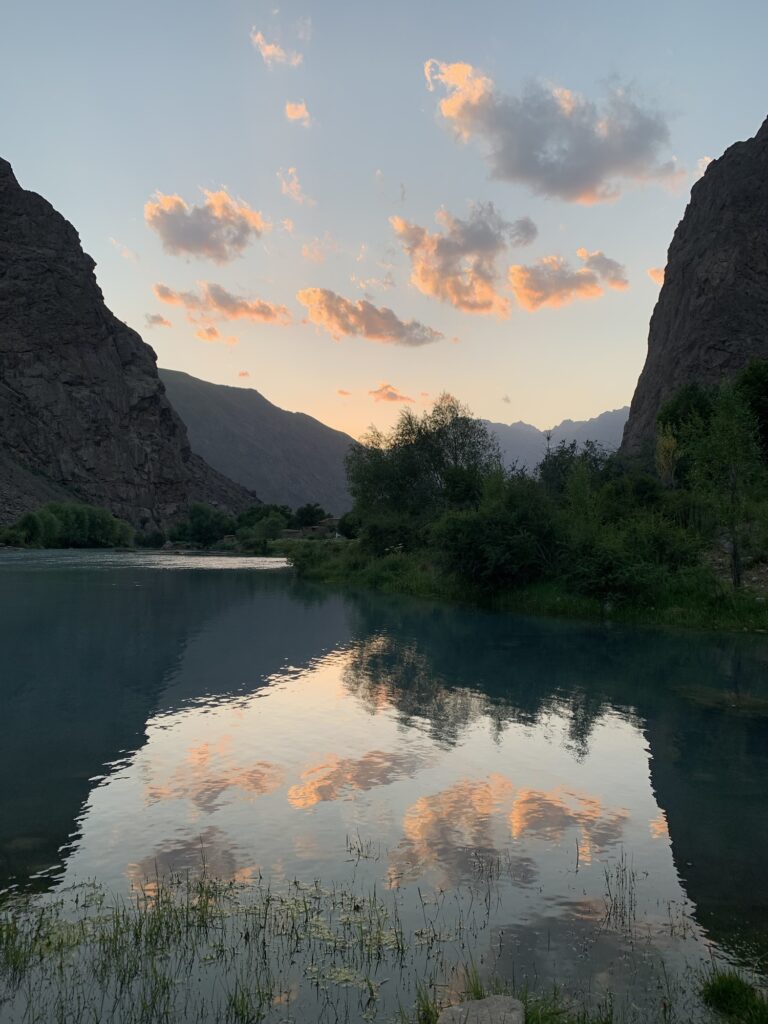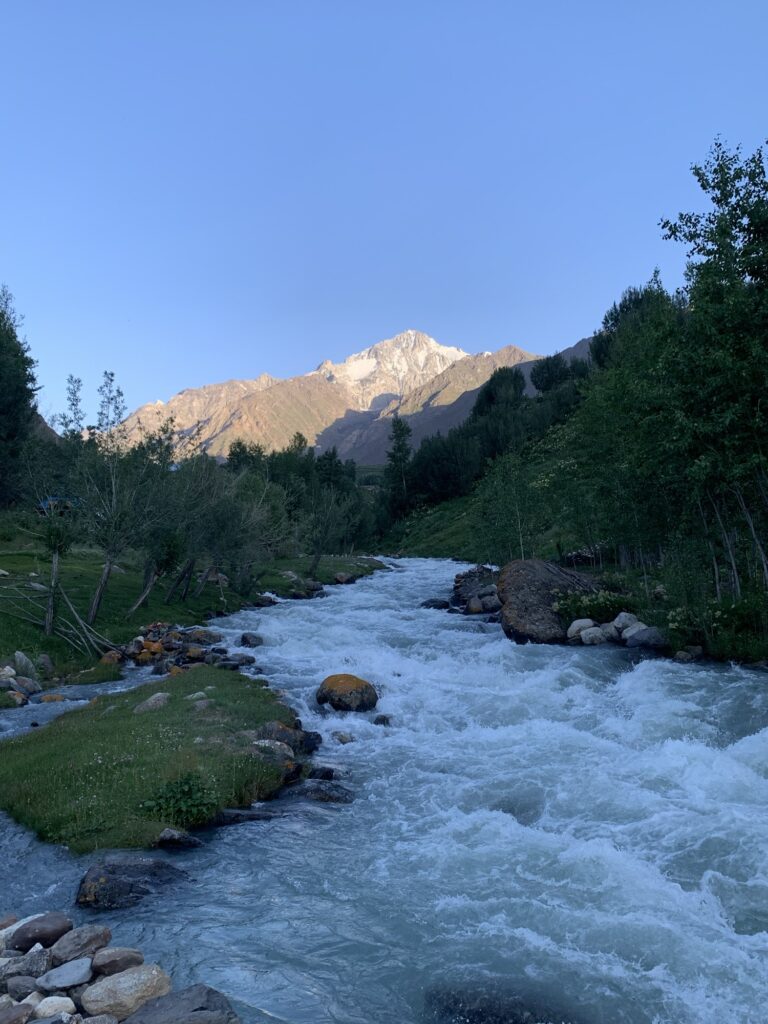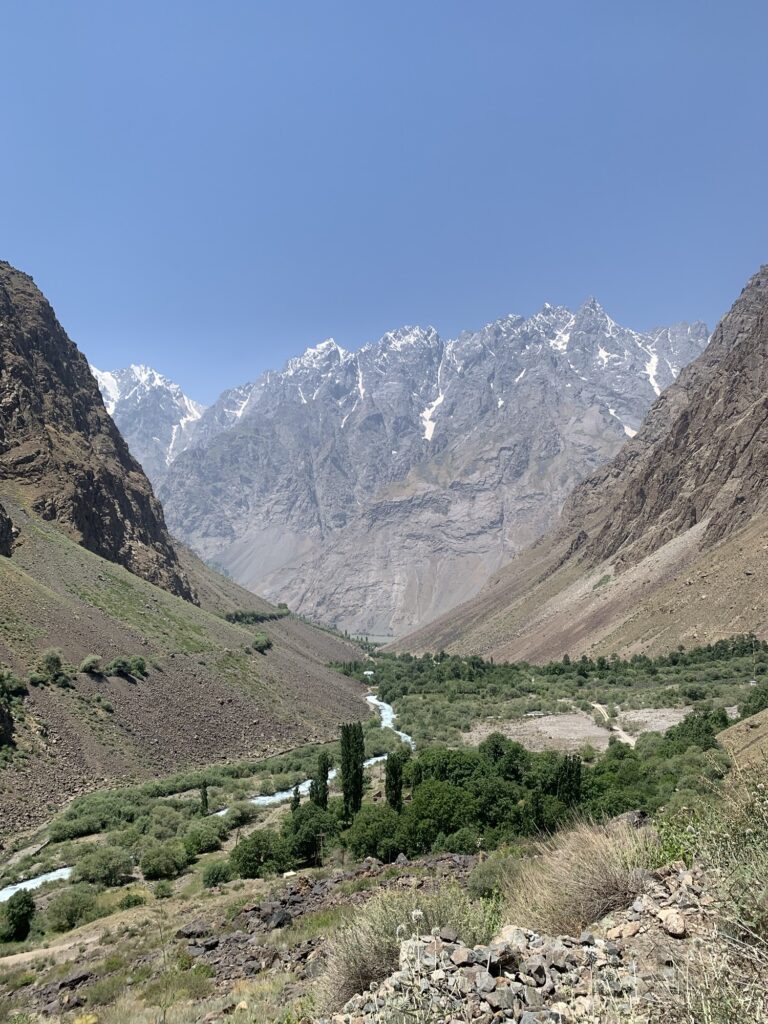Our entry into Tajikistan was about as far from an arrival at an international airport as one can get. We set off on foot from the Kyrgyz village of Sary Mogul, under stormy skies. On the other side of the 20km wide valley stood the famed Peak Lenin, at over 7000m. The plan being to cross the valley, then traverse 40km to the Kyrgyz border post on the Pamir highway, before crossing the no-man’s land into Tajikistan.
Our evening camp at the base of Peak Lenin is majestic, with the rain only falling once we’re in the tent, and even enough sun for a dip in the lake and a walk around the yurts, as yaks and sheep streamed back after the day’s grazing. Occasionally we caught a glimpse of the glaciers above us, a ridge, or perhaps the summit, but the full peak never revealed itself to us.
This whole valley, at 3500m, is well above the tree-line, only tough grasses and plants manage to eke out an existence but marmots thrive and wolf prints stand out in the mud. The rolling green hills we traverse are also a perfect pasture for flocks of fat tailed sheep in their hundreds, accompanied by horses, shepherds, and their families living in the summer yurt camps.
This bucolic Kyrgyz scene contrasted with the backdrop of raw ice and rock of the Pamir-Alai mountain range, glaciers spilling down and feeding rivers that must truly rage during spring snow melt. Our off-track traverse included many river crossings, including a rocky river bed 2km wide, thankfully with the water restricted to a few braided streams.
At certain times during the walk, with thunder and rain coming down on us, and seeming to make little progress across this vast landscape, there were some moments of doubt, but doubts were dominated by our awe at the lunar, wild, hostile yet enchanting alure of this country. What a special place to be, feeling so insignificant when confronted with such scale.
Higher up, light snow swirled around us as we woke in no-man’s land between the Kyrgyz and Tajik border posts, with a muddy 10km climb to the Kyzyl Art pass that marks the border of these two countries. The soldiers of the last Kyrgyz military post invited us in for tea, bread and butter. Ten are packed in the little hut, the coal fire roaring, cooking Plov for lunch and playing checkers. An hour later we cross into Tajikistan, at 4283m, the snow is blowing sideways and it’s only thanks to the road starting to descend and a roadside statue that we know we’ve changed countries. A further 2km downhill and we’re stamped into Tajikistan at the border post.
We explain we would like to wait to see of we can hitch a ride with any cars going into Tajikistan, the Tajik soldiers and customs officers set us up in their cosy bunk room, where we spend the next two hours watching Russian soap operas waiting for a car. Thankfully, a tourist car came through with space to take us through to Karakul, a magnificent yet desolate village of white adobe houses on the shores of lake Karakul.
The « banya », the guest house shower consisted of a small building in the backyard, where a yak dung fuelled fire heats a big bucket of water, and the room, creating the most delightful sauna / shower while snow was blowing across the plains outside. The family running the guest house were delightful, we cooked bread with them in the outdoor tandoor, danced, played and drew. Their home and our room was heated by small yak dung stoves and covered in felt and woven carpets.
Life must be very tough for all here in the high Pamir. It’s mid-June, late spring, and snow swirls in the air while a few green shoots struggle to emerge from the dry ground. Minus 20 degrees C isn’t uncommon in winter. Yaks and sheep are the only source of food, with flour and potatoes bought from elsewhere. Malnutrition is an issue here and the World Food Program and NGOs are present, investing in green houses and providing school meals.
This area of the high Pamir is peopled by ethnic Kyrgyz, different in both lifestyle and aesthetic to the Pamiris who are more concentrated in the valleys. Murghab, the district centre, is home to both communities and feels like a forgotten outpost at the end of the world. Wind sweeps through, there’s hardly any electricity, no running water and no phone reception while we’re there. All public buildings are adorned with the image of the president, part of his personality cult effort, and public radio plays eerily through the streets. Independent travelers are fairly rare here, there’s some hardy (crazy?) cyclists, overlanders, and only one or two people hitching and hiking like us. Most travelers visit the Pamir in a 5-6 day package tour racing through in groups in a 4WD.
With no public transport in this area and maybe only 1 or 2 vehicles a day on some routes, hitching is uncertain, so we’re carrying almost 14 days of food (couscous + oats!) and plan to walk as much as possible through this unique landscape. From the town of Alichur we head out off the main road towards some hot springs spotted on the map. Almost 30km across stony desert at 4000m of altitude with occasional salt lakes, and towering rocky mountains on either side of us. Another magnificent lunar landscape. A river brings life and a bit of green pasture to the rock, and for the first time in our lives we see a geyser spluttering.
The hot springs at the end of the day are magical, stinging hot, with the cool river next to us to plunge into. Apparently there are many marco polo sheep (argali), the biggest sheep in the world, around these mountains. Much of the local fauna took a big hit after the breakup of the USSR and the ensuing civil war, with almost starving Pamiris relying on what they could hunt, and the aid trucks that were able to get through. Food wise, the situation is better now, with a shift away from the Soviet command economy and back to sustenance farming in the valleys. However, there is a severe lack of economic development and opportunities beyond tourism, many families are very poor, and every family we met had at least one family member working in Russia.
Continuing our walk, we explored abandoned caravanserais, mausoleums, and other relics of the silk roads, and spent days traversing stony desert, somehow alive with alpine cushion plants, and small birds. The sun was so strong that we had to wear balaclavas and gloves, covering everything. On day three we camped by a high altitude salt lake on the dirt track leading to the wakhan corridor. Just as we were setting up the tent, wolves began to howl, it certainly set our nerves on edge, despite knowing the risk for humans is minimal.
Almost 100km into our hike, and at 4800m, a magnificent viewpoint offered panoramic views south to the Hindu Kush, just across the river in Afghanistan, and east to the high altitude valleys where Afghanistan, Tajikistan, Pakistan and China meet. The terrain of the snow leopard and marco polo sheep. We covered the remaining 70km to the first village in the wakhan valley in just a few hours, hitching in the boot of a Landcruiser.
The sight of the first trees in nearly two weeks, and soon lush fields watered by irrigation canals, brought immediate relaxation. We set up camp looking out over the ruins of a silk road fortress, with the peaks on the afghan side rising to icy spires in front of us. Over the following week of walking and hitching we explored the picturesque villages of the wakhan valley, admiring the traditional houses, ancient fortresses, hot springs, and intensely cultivated fields irrigated with sediment rich glacial meltwater. Potatoes and wheat dominate, wheat being grown with beans or peas to provide nitrogen. We spent a couple of days lounging like kings and queens of old on the outdoor cushion covered day beds found across central asia. The Tapchan will be an essential addition to any future home of ours, especially if we can also replicate the endless supply of tea, almonds, apricots and dried mulberries!
As in northern Pakistan, people here are ismaili muslims, with the Agha Khan as their spiritual leader. However, in the Pamirs, religion and the activities of the Agha Khan Development Network (schools, health centres, agricultural projects) have recently been strictly curtailed as the Tajik government fears Pamiri autonomy and self empowerment. Protests two years ago saw soldiers kill a number of pamiris and a climate of fear now prevails. The Soviet period also transformed the societies and economies of the valley, and we had the impression that community organisation was less strong, and traditional ways of life less prevalent relative to Pakistan.
All this being said, Pamiris are incredibly hospitable, especially in less touristy areas. On many occasions we were offered tea, bread, and more. Hiking in the magical Khuf and Jisev valleys, the smells of fresh cut hay filled the air, as villagers cut prairies with their sicles and made piles for the hay to dry before storing it on their roof for the winter. We were invited into a shepherds hut for tea and bread with fresh rich cream and yoghurt, delicious !
Frustratingly, our lack of Russian or Pamiri language skills, and limited local English, reduced opportunities for deeper exchanges. Sharofat was the exception, a guesthouse owner and grandma in Khorog, Sharofat speaks perfect English and we spent four nights camping in her garden and chatting about her love of Pamiri antiques, local culture, the current political climate, and more. She has sent her son overseas to study and is worried it’s not safe for him to return given the current government crackdown on Pamiris. We go with Sharofat to the local Afghan market, one of many markets that the Tajik government organises along the border, allowing Tajiks and Afghans to trade. The Afghans are all dressed very smartly in their shalwar kameez, with waistcoats and pakol hats. Many have piercing blue eyes or red hair and all are keen to chat or at least say hello with a smile.
The further we descend into the valleys, the more we come across the national dish of Tajikistan, Kurutob. A delicious mix of yoghurt sauce, with freshly fried layered bread, onions, boiling linseed oil, and a salad of tomatoes, cucumber, dill and coriander, all mixed together to make my perfect dish! Kurutob with a jug of local compot, or stewed fruit juice, is the perfect meal on a hot day. So good that we indulge at least 5 times over our last few days in Tajikistan, followed up by copious amounts of melon of course.
After leaving the Pamirs we descend through the valleys cut by the raging Panj river, the Oxus of the Greeks, that becomes the Amu Darya. Here we see it as an untamed, terrifying beast of a river in flood, but as it reaches the plains, its force is sapped by canal after irrigation canal, leaving only the occasional trickle to make it all the way to the Aral Sea.
In the capital, Dushanbe, we delight in air conditioning (+40 degrees C outside) and explore art galleries and carpet shops. The city is undergoing a huge construction boom, with many of the beautiful old russian era buildings being knocked down to be replaced with grotesque neoclassical concrete and glass structures. We don’t know who’s paying for this and who will live in the new buildings, but there certainly is a huge Chinese construction presence across the country. Despite this transformation, the city feels lively and interesting, with some excellent displays in the museums and galleries. A great place to rest up a little before we start racing westward towards Europe.
As I write this we’re 1200km into a train journey across the Kazakh steppe, very nice… it’s as flat as a pancake and dry dry dry here. The Pamir already seems a world away. We’re so glad to have had over three months to explore central asia, a fascinating part of the world, and the last month in the mountains of Tajikistan. The rich artistic and agricultural traditions, cultural cross roads, and magnificent geography of this part of the world motivate us to learn more, and hopefully return!
